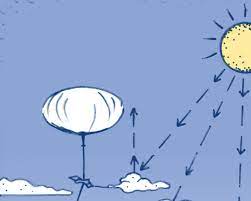Stratospheric Aerosol Intervention : Study

A recent study looked at the impact of stratospheric aerosol intervention (SAI) in mitigating global warming effects in West Asia (also known as the Middle East) and North Africa (MENA).
- Stratospheric Aerosol Intervention (SAI) also known as Stratospheric Aerosol Injection, is a geoengineering or climate engineering approach that uses tiny reflective particles or aerosols to reflect sunlight into space in order to cool the planet and reverse or stop global warming.
- It aims to mimic the cooling effects of volcanic eruptions by injecting Sulphur dioxide (SO2) directly into the stratosphere, where it forms sunlight-reflecting sulphate aerosols.
- The 1991 eruption of Mount Pinatubo in the Philippines, often cited as the inspiration for this concept, deposited massive amounts of particulate matter and Sulphur dioxide (SO2) into the atmosphere.
- This aerosol layer was reported to have lowered average temperatures around the world by about 0.5 °C (0.9 °F) over the following few years.
- It is believed that as more radiation is scattered in the stratosphere by aerosols, less would be absorbed by the troposphere, the lower level of the atmosphere where weather primarily occurs.
- The production of such an artificial aerosol layer could be accomplished by shooting Sulphur particles into the stratosphere with cannons or dispersing them from balloons or other aircraft.
- Aerosols are tiny solid or liquid particles suspended in air or gas.
- Aerosols can be natural, such as fog or gas from volcanic eruptions, or artificial, such as smoke from burning fossil fuels.




